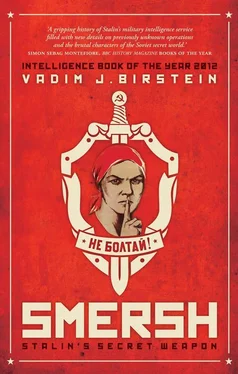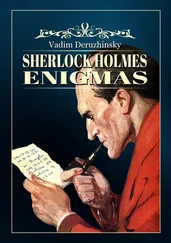Although SMERSH existed for only three years, from 1943 to 1946, the two years prior to its formal organization (when Abakumov was chief of its direct predecessor, the UOO), and the five years after its demise (when Abakumov was head of the MGB), must be considered as part of its history. There is a continuous thread, during those ten years, of Abakumov’s special relationship with Stalin.
Until now, there has been a lack of understanding, in the historical literature, of the part played by Abakumov. Abakumov’s role as head of the UOO, SMERSH, and then the MGB was shrouded in secrecy. He was not a member of the Communist Party or Soviet government leadership, and portraits of him were not publicly displayed anywhere in the Soviet Union. Until recently, even the Russian State Archive of Film and Photo Documents, which keeps all documentary films and numerous photos of the Soviet period, did not have Abakumov’s picture. There are perhaps only seven or eight photographs of him in existence, and I know of only one occasion, in March 1946, when the newspaper Pravda published a photograph of him—sitting next to Marshal Georgii Zhukov, the conqueror of Berlin. Even in the Soviet Union, very few people knew that the MGB, the most feared security service, was headed by Abakumov and not by Beria. 71
In contrast, two books have been published in English about Lavrentii Beria, who was quite famous during his time in Moscow. 72Every Soviet citizen was familiar with Beria’s appearance because photographs of him were frequently published in newspapers. Also, his portraits, along with those of the other Politburo members, were posted on buildings in every city and town during official Soviet holidays—the 1st of May (International Labor Day) and the 7th of November (Bolshevik Revolution Day). Yet the period during which Beria was head of all the security services only lasted for five years, from 1938 until 1943. After the creation of SMERSH, Beria had to compete with Abakumov for influence.
From 1943 on, as NKVD Commissar, Beria was formally in charge of managing the NKVD labor camps and prisons, but through his close associate, Vsevolod Merkulov, Beria also effectively controlled the NKGB, which was responsible for foreign intelligence and internal counterintelligence. However, after 1943 he was never again, during Stalin’s life, the all-powerful security chief he had once been.
On December 29, 1945, Beria, who was still a deputy chairman of the Council of Commissars, was appointed head of the Soviet Atomic Project, while Sergei Kruglov, his devoted and rather colorless deputy, became the head of the MVD (Internal Affairs Ministry, the successor to the NKVD). Therefore, contrary to what is generally believed, from the beginning of 1946 until Stalin’s death on March 5, 1953, Beria did not head any of the Soviet secret services. As a member of the Politburo, each of which was assigned a group of ministries to supervise, for the next year Beria oversaw the work of the MGB and MVD, as well as that of ten other ministries, although this supervision was primarily administrative. In February 1947 even this supervisory role was taken away. In July 1947 Abakumov refused to follow Beria’s orders regarding the construction of facilities by the MGB for the atomic project. 73
By September 1947 it was clear that Beria had lost all control over the state security services. Abakumov, on the contrary, continued to amass power, managing to get several MVD directorates incorporated into his MGB. In terms of his control over state security, Abakumov was far more powerful from 1946 to 1951 than Beria had been from 1938 to 1943.
In 1947, Abakumov’s MGB lost responsibility for foreign intelligence (its 1st Main Directorate) when Stalin merged it, along with military intelligence (GRU or the Main Intelligence Directorate) and diplomatic and Party intelligence services, into a new organization called the Committee on Information. Undaunted, in October 1949, Abakumov established a new 1st Directorate, charged with counterintelligence on foreigners and on Soviet personnel abroad. It was headed by Colonel Georgii Utekhin, who had headed departments in SMERSH headquarters that were in charge of capturing enemy agents in the Red Army rear and sending SMERSH agents to the German intelligence schools.
As he had done to so many people before, Stalin decided to purge Abakumov, and on July 12, 1951, he was arrested. Many high-ranking SMERSH officers, including Selivanovsky, Likhachev, Belkin, and Utekhin, were also detained. By the beginning of 1953 Stalin pretended that he had nothing to do with the appointment of Abakumov as MGB minister. Stalin told those investigating Abakumov’s case that in 1946 Beria had insisted on Abakumov’s appointment and that was why he ‘did not like Beria and did not trust him’. 74Apparently, Stalin was preparing to use the Abakumov case as a tool against Beria.
Nikita Khrushchev, who emerged as the Soviet leader soon after Stalin’s death in March 1953, played a big part in concealing Abakumov’s real role. During the de-Stalinization campaign that started with Khrushchev’s secret speech at the Twentieth Soviet Communist Party Congress in 1956 and continued at the Twenty-second Congress in 1961, as well as in a series of speeches at other Party meetings, Khrushchev repeatedly mentioned Abakumov as ‘an accomplice’ of Beria. Apparently, Khrushchev wanted to make Beria the primary villain of the Stalin period in order to expedite Beria’s speedy trial and execution at the end of 1953. By the way, the text of Khrushchev’s speech of 1956, published in many languages that same year, appeared in press in the Soviet Union only in 1989.
After Stalin’s death on March 5, 1953, Beria was appointed first deputy chairman of the Council of Ministers and Minister of Interior Affairs (MVD). This was a new MVD that included both previous ministries, the MGB and the MVD. In other words, Beria restored the monolithic NKVD structure that had been in effect from 1941–43. However, the new MVD was much bigger than the NKVD of 1941–43, and Beria acquired enormous power.
To counter this threat, Georgii Malenkov, Vyacheslav Molotov and Khrushchev united, and on June 26, 1953, with the help of Georgii Zhukov, first deputy Defense Minister, Beria was arrested as an alleged spy and enemy of the people. On December 23, 1953, the Special Session of the USSR Supreme Court sentenced Beria to death and he was executed. Beria’s longtime colleagues—Vsevolod Merkulov, Vladimir Dekanozov, Bogdan Kobulov, and Sergei Goglidze, whom he brought from the Caucasus in 1938, as well as Pavel Meshik and Lev Vlodzimersky, who became his trusted men in Moscow—were also convicted and shot.
The investigation of Abakumov continued for a year after Beria’s execution. When Roman Rudenko, the newly appointed Soviet chief prosecutor, was interrogating Abakumov in 1953–54, he tried in vain to connect Abakumov with Beria. Abakumov firmly stated: ‘I’ve never visited Beria’s apartment or his dacha. We had a strictly official, working relationship, and nothing else.’ 75
Abakumov and his devoted men—Aleksandr Leonov, former head of the SMERSH Investigation Department, and two of his deputies, Likhachev and Vladimir Komarov, as well as Ivan Chernov, former head of SMERSH’s Secretariat, and his deputy Yakov Broverman—were tried by a special session of the Military Collegium of the Supreme Court in Leningrad from 12–19 December, 1954. 76As ‘a member of Beria’s gang’, Abakumov was accused of treason against the Motherland, terrorism, counter revolutionary acts, and so forth. None of these accusations made any sense. Abakumov pleaded not guilty, stating that ‘Stalin gave instructions, and I only followed them’. 77This was true. As Chernov recalled, during the announcement of the death verdict ‘not a muscle moved in Abakumov’s face, as if the announcement did not concern him’. 78Abakumov, Leonov, Likhachev, and Komarov were executed on December 19, 1954, immediately after the trial. Chernov and Broverman were sentenced to imprisonment in labor camps, for 15 and 25 years respectively.
Читать дальше












